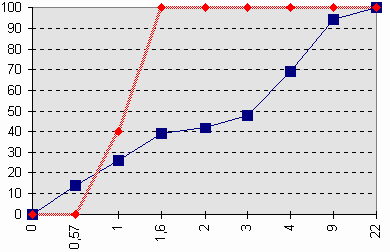AURAN
Gold Vapor Laser System for Photodynamic Therapy
Main
Laser system
Application in oncology
Clinical practice
Our address
CORYRIGHT
2001 ©
O.Ponomareva
|
Table 1
Cytological and histological investigations were performed for all the patients prior to, during and after treatment. Over a period up to 1996, PDT was applied to 138 patients (236 tumors). For 47 patients PDT was a first method of treatment, which surgical treatment, radio - and chemotherapy applied for the remaining patients. After a first PDT course, the tumors have disappeared completely in 72 patients (55 %), have decreased in 32 patients (24 %) by no less than 75 % and in 19 patients (15 %) 0 no less than 50 %. In the case of 8 patients (6 %) PDT was low effective for all or at least one tumor tumors regression was below 50 %). According to our data, a localization of tumors did not exert considerable inluence on PDT immediate results. Table 1 cites remote PDT results for the patients with tumors of a different histological type. In the process of PDT, possibilities were found out to expand a sphere of applications of this method, for which purpose, new PDT methods have been proposed with the account of localization of a tumor process, the histological form of tumor, its volume and spread:
On the basis of the obtainable results, one can make a number of conclusions:
Tumors destruction
On treatment of bronchi, trachea, larynx, nasopharynx, the use of GVL facilitated a patients state over a shorter period of time in comparison with other lasers; highly effective was it in treating basal cellular cancer. Possibly the reason behind the earlier direct results of PDT with GVLs is the pulse, nature and high pulsed radiation power of this laser. Besides this GVLs generate short nanosecond pulsed with a peak power of about 10 kW, following at an interval of tens of microseconds, which exceeds a duration of laser pulse upwards of 4.000 times. This circumstance apparently influences a mechanism of inducing a photosensitizer in the tumor tissue. More information: |
